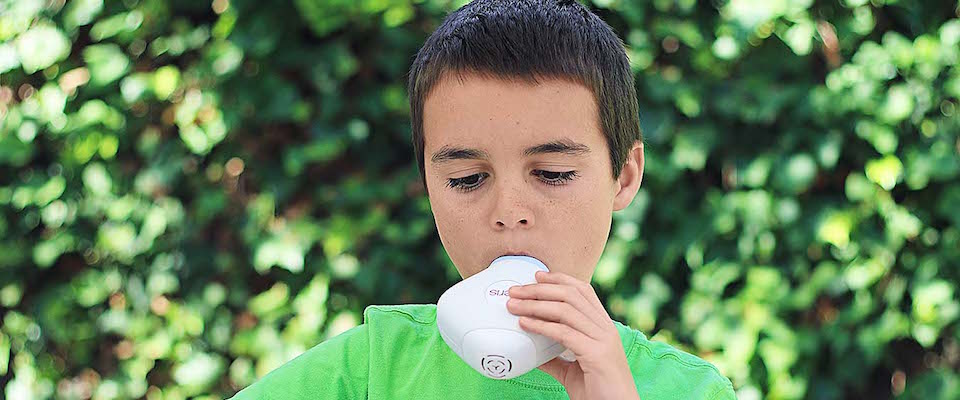To a very real degree, Charvi Shetty’s future was molded by her college roommate. Or rather, her roommate’s health.
“She had asthma,” says Shetty, who graduated from UC Berkeley with a bioengineering degree in 2012 and took a master’s in biomedical imaging from UCSF in 2013. “She had to use an inhaler six times a day. She told me that her childhood memories were of going to the ER, not Disneyland or the beach, and she was never allowed to play outside because of her allergies. Asthma controlled her life.”
Early detection isn’t just a matter of comfort, Shetty emphasizes. “When they appear, symptoms can quickly become so severe that the patient has to go to the ER,” Shetty says. “It can literally be a matter of life and death.”
Shetty’s sudden awareness of this affliction inspired her senior project in biodesign: a prototype for a portable spirometer. Spirometers are devices that measure the volume of air taken in and expelled by the lungs. Physicians use the equipment to determine lung function, diagnose certain pulmonary diseases (including asthma), and measure the efficacy of treatment.
“One in 12 people in the U.S. suffers from asthma,” says Shetty, “but the technology for monitoring and testing really hasn’t caught up with the need. Spirometers are really important equipment for asthma sufferers because a decrease in lung function can often be identified before there are any overt symptoms, like wheezing or shortness of breath. If you can identify a problem early, the patient can receive treatment before experiencing any symptoms.”
Early detection isn’t just a matter of comfort, Shetty emphasizes. “When they appear, symptoms can quickly become so severe that the patient has to go to the ER,” Shetty says. “It can literally be a matter of life and death.”
Shetty’s classroom prototype for the spirometer, named Aeris, wasn’t functional, but she didn’t give up on it. With fellow UC engineering alums Huyson Lam and Inderjit Jutla, she founded her own company, Knox Medical Diagnostics, to refine the prototype. Her work caught the attention of physicians at UCSF’s medical school.
“They had identified a real problem with the availability of critical diagnostic equipment,” says Ngoc Ly, chief of pediatric pulmonology at UCSF, “so we decided to help them with development and testing.”
Most spirometers are bulky and expensive, and only about a quarter of U.S. hospitals have them. Some models are permanently fixed units that literally surround the patient and cost $30,000 or more. Others are somewhat cheaper but still not portable, and both varieties require a trained laboratory technician for proper operation and data verification.
Says Ly, “We have a very large number of patients with chronic lung disease, including asthma, and for some of them, it’s really hard to get into a clinic for testing. A true spirometer that is both portable and affordable could have a huge impact in our field.”
So far, the Knox team and UCSF pulmonologists have been able to refine the Aeris so that initial findings suggest its readouts are equal in accuracy to those of standard clinical spirometers. “The values for the flow loops (a cycle of inhalations and exhalations that are sufficient to yield data on lung function) from both the Aeris and standard spirometers are pretty consistent with each other,” says Ly.
A big part of the problem is that kids have a hard time communicating how they’re feeling. They may be shy, or their language skills may be inadequate, and they end up with severe symptoms before adults know what’s going on. So the Aeris does their communicating for them.
Word on the device is spreading. The National Science Foundation awarded Knox a $225,000 grant for its work and machine-learning algorithm, and Shetty has been getting a lot of inquiries. The company has been in touch with the medical schools at Harvard and University of Texas at Austin, “but most of the emails have been coming from parents,” she reports, “and that’s not a coincidence. The Aeris is designed for kids.”
Shetty observes that there are more than 10 million children in America with asthma. “It’s the third leading reason for hospitalization for people under 15,” she says, “and even though they constitute just 25 percent of the asthmatic population, children account for half of all asthma-related hospital stays. A big part of the problem is that kids have a hard time communicating how they’re feeling. They may be shy, or their language skills may be inadequate, and they end up with severe symptoms before adults know what’s going on. So the Aeris does their communicating for them. The device is used in wireless conjunction with an iPhone app. Kids employ a game controller to manipulate a hot air balloon on the phone’s screen. When they breathe out, the balloon goes up; when they breathe in, it goes down. The game rewards them with digital coins and fishes. The child is taken to different virtual destinations, and encouraged to work through Aeris’s protocols until a pulmonary status is ascertained. A display provides an immediate evaluation: Agreen light means everything is fine; yellow means medication is needed; and a red light means a trip to the ER is warranted. The data can be output to a PDF, and at Knox they’re working on directly transmitting to clinics or hospitals via the iPhone.
The app created an unexpected problem. “The kids who tested it loved it so much, they wanted to play with it all the time. If you play it constantly, it can lead to shortness of breath, which isn’t good. So we adjusted the game so it only goes to one destination a day, and that was enough to discourage excessive play.”
Ly says such “coaching systems” are critical for the development of any home-use spirometer. “The software is fulfilling the function of the technician who directs the patient on a clinical spirometer. Once you learn the technique, you can do it. But you need the device to provide the right incentives, the right prompts.”
Knox and UCSF are now seeking subjects for an expanded study to confirm the initial study’s results. In the meantime, the company plans to apply for FDA approval—which means the Aeris may soon be available to patients.
For Shetty, that would be a satisfying coda to her years at Cal, when she shared quarters with a chronic asthma sufferer. “Whenever I make a presentation, I always start with her story,” she says. “Asthma robbed her of her childhood. We want to do everything we can to ensure other kids don’t have to suffer like she did.”



















